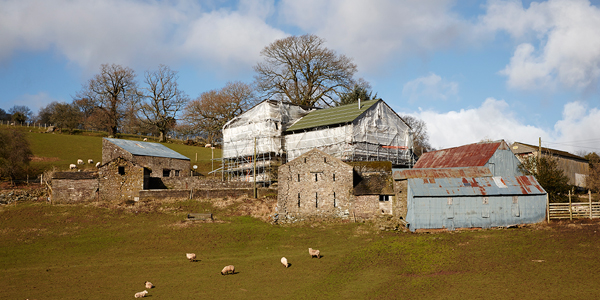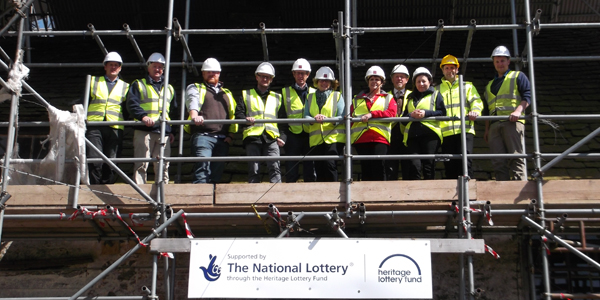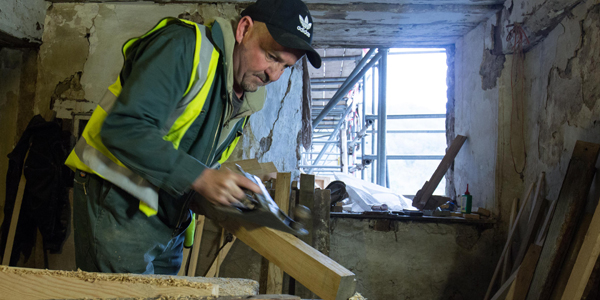First impressions
I think the thing I most remember about my first visit to Llwyn Celyn was the smell. What it looked like was almost impossible to tell. A great tattered mass of torn and tangled plastic sheeting billowed from the huge emergency scaffolding tent over the building that had been put up years before. Somewhere under this was a house. As you entered the gloom you were greeted by the grim odour of rot, of stagnant water, of sodden, decaying wood. Bats’ urine trickled in slow waterfalls down the plaster walls and occasionally a great flapping flock would come careering from the darkness, grazing your hair as they passed. Growing up in the sheep farming hills of the Scottish Highland I had been into my fair share of collapsing farmhouses. But you could see from the moment you entered Llwyn Celyn that, despite its near-dereliction, this was something truly exceptional.

A welsh medieval survivor
What lay hidden was a medieval house, almost unaltered for the last 350 years. Beautiful, elaborately carved wooden doorways led off what was once a central great hall. A carved bench where the lord sat to eat and receive visitors remained in place. The soaring structure of the medieval roof was still there, its timbers blackened by the smoke from the fire that once burned in the midst of its stone floor. It was built, we would learn, on the lands of the medieval priory of Llanthony and its story would be bound up in that ancient place and the story of Wales itself.
The Landmark Trust has been rescuing historic buildings, and making them into places which everyone can rent for holidays, for over fifty years. But even we took a deep breath at the prospect of this one. The Grade 1 listed house was on the building equivalent of a life support machine, and one that might itself give up at any moment. Acrow props formed metallic copses in the ground floor rooms, holding up the ceilings above; bent coat hangers held scores of the great stone tiles on the roof in place and soggy sandbags dammed the doorways from the muddy streams that trickled through the house.
But we decided to take the plunge, convinced that the building would prove itself worth it. We acquired Llwyn Celyn (‘holly grove’ in Welsh) in 2012 and embarked upon the monumental task of saving this extraordinary house, trying to unravel its fascinating past and using the finest craftspeople to bring it back to life. It has been an epic journey. To mend the house, its many important ancillary building and repair it as a Grade 1 listed building should be repaired, cost over £4 million. We raised this thanks to a hefty grant from the Heritage Lottery Fund and donations from hundreds of others - many ordinary individuals who felt like us that this was a place worth saving.

Saving Llwyn Celyn
The brilliant, assured and highly skilled team of specialists and craftspeople on the project were a pleasure to work with and to watch. Whatever the weather – and it could be truly bleak – they toiled on over almost three years, achieving the near impossible with amazing good grace. On one visit I was flabbergasted to see that the top of a carved medieval door which had over the centuries slumped to a diagonal had been somehow straightened. When I asked how on earth they had achieved this, what they had done to wreak this miracle, the twinkly answer was, ‘that miracle is called Mac’, their master carpenter.
The challenges they and we had to deal with were real. The bats were a massive headache, how to claim this house back from them without harming them – and without being prosecuted. Like Rumsfeld we knew there were things we did not know, and things we would only discover once we started taking the house apart. As we opened up the building, taking off the roof, lifting the floors, digging out the collapsed hillside behind, things were revealed that we could not have imagined.
Today Llwyn Celyn is quite literally unrecognisable. Its smell is now one of beeswax, fresh paint and warm stone. To have been part of the process has been a renewal in itself. Right at the start we teamed up with More4 in the belief that this rescue would be worth watching. How right we were. If you need a tonic to the troubles of our times look no further than this project. It is the story of us and our ancestors, of their talents passed on, of what it takes to create great strength and great beauty. Above all it reminds you that some things still matter simply because enough of us believe they matter, and if they are broken, we can come together and mend them.

Discover more about Llwyn Celyn